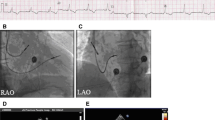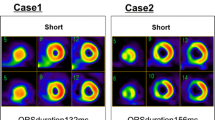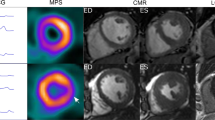Abstract
Patients with isolated congenital complete atrioventricular block (CCAVB) occasionally develop dilated cardiomyopathy (DCM), despite early pacemaker implantation. However, the etiology of the DCM and its relationship to permanent ventricular pacing are not fully understood. Twenty-five patients with CCAVB underwent 99m technetium (Tc) myocardial perfusion scintigraphy. Five patients were studied before and after pacing, providing a total of 30 image sets, which were divided into three groups; group 1: CCAVB before pacemaker implantation (PMI) (n = 11); group 2: CCAVB after PMI who did not subsequently develop DCM (n = 13); group 3: CCAVB after PMI who subsequently developed DCM (n = 6). Perfusion defects on single-photon-emission computed tomography (SPECT) were identified in group 1, 0 of 11 patients; group 2, 85% of patients; and group 3, 100% of patients. In groups 2 and 3, in patients with right ventricular pacing, the perfusion defects were mainly in the septum or between the apex and septum. On 20 segments’ polar maps, the distribution of %uptake showed a similar pattern in groups 2 and 3, the degree of decreased %uptake and the number of segments with decreased %uptake being more severe in group 3. “Artificial” left bundle branch block (LBBB) pattern myocardial contraction induced by right ventricular pacing decreased myocardial perfusion around the apex and septum. Some patients with CCAVB will develop left ventricular dysfunction caused by artificial LBBB-induced interventricular asynchrony.



Similar content being viewed by others
Abbreviations
- CCAVB:
-
congenital complete atrioventricular block
- DCM:
-
dilated cardiomyopathy
- LBBB:
-
left bundle branch block
- LV:
-
left ventricle
- LVEF:
-
left ventricular ejection fraction
- PMI:
-
pacemaker implantation
- RV:
-
right ventricle
- SPECT:
-
single-photon-emission computed tomography
- Tc:
-
technetium
References
Auricchio A, Stellbrink C, Block M, Sack S, Vogt J, Bakker P, Klein H, Kramer A, Ding J, Salo R, Tockman B, Pochet T, Spinelli J (1999) Effect of pacing chamber and atrioventricular delay on acute systolic function of paced patients with congestive heart failure. Circulation 99(23):2993–3001
Baker CM, Christopher TJ, Smith PF, Langberg JJ, Delurgio DB, Leon AR (2002) Addition of a left ventricular lead to conventional pacing systems in patients with congestive heart failure: feasibility, safety, and early results in 60 consecutive patients. Pacing Clin Electrophysiol 25(8):1166–1171
Friedman RA, Fenrich AL, Kertesz NJ (2001) Congenital complete atrioventricular block. Pacing Clin Electrophysiol 24(11):1681–1688
Germano G, Kiat H, Kavanagh PB, Moriel M, Mazzanti M, Su H, Van Train KF, Berman DS (1995) Automatic quantification of ejection fraction from gated myocardial perfusion SPECT. J Nucl Med 36(11):2138–2147
Grines CL, Bashore TM, Boudoulas H, Olson S, Shafer P, Wooley CF (1989) Functional abnormalities in isolated left bundle branch block. The effect of interventricular asynchrony. Circulation 79(4):845–853
Jaeggi ET, Hamilton RM, Silverman ED, Zamora SA, Hornberger LK (2002) Outcome of children with fetal, neonatal or childhood diagnosis of isolated congenital atrioventricular block. A single institution’s experience of 30 years. J Am Coll Cardiol 39(2):130–137
Karpawich PP, Rabah R, Haas JE (1999) Altered cardiac histology following apical right ventricular pacing in patients with congenital atrioventricular block. Pacing Clin Electrophysiol 22(9):1372–1377
Kerwin WF, Botvinick EH, O’Connell JW, Merrick SH, DeMarco T, Chatterjee K, Scheibly K, Saxon LA (2000) Ventricular contraction abnormalities in dilated cardiomyopathy: effect of biventricular pacing to correct interventricular dyssynchrony. J Am Coll Cardiol 35(5):1221–1227
Michaelsson M, Riesenfeld T, Jonzon A (1997) Natural history of congenital complete atrioventricular block. Pacing Clin Electrophysiol 20(8 Pt 2):2098–2101
Moak JP, Barron KS, Hougen TJ, Wiles HB, Balaji S, Sreeram N, Cohen MH, Nordenberg A, Van Hare GF, Friedman RA, Perez M, Cecchin F, Schneider DS, Nehgme RA, Buyon JP (2001) Congenital heart block: development of late-onset cardiomyopathy, a previously underappreciated sequela. J Am Coll Cardiol 37(1):238–242
Ono S, Nohara R, Kambara H, Okuda K, Kawai C (1992) Regional myocardial perfusion and glucose metabolism in experimental left bundle branch block. Circulation 85(3):1125–1131
Piepsz A, Hahn K, Roca I, Ciofetta G, Toth G, Gordon I, Kolinska J, Gwidlet J (1990) A radiopharmaceuticals schedule for imaging in paediatrics. Paediatric Task Group European Association Nuclear Medicine. Eur J Nucl Med 17(3–4):127–129
Skalidis EI, Kochiadakis GE, Koukouraki SI, Chrysostomakis SI, Igoumenidis NE, Karkavitsas NS, Vardas PE (2001) Myocardial perfusion in patients with permanent ventricular pacing and normal coronary arteries. J Am Coll Cardiol 37(1):124–129
Takasugi H, Watanabe K, Ono Y, Echigo S (2005) Improvement of left ventricular function after changing the pacing site in a child with isolated congenital complete atrioventricular block and dilated cardiomyopathy. Pediatr Cardiol 26(1):87–89
Taylor-Albert E, Reichlin M, Toews WH, Overholt ED, Lee LA (1997) Delayed dilated cardiomyopathy as a manifestation of neonatal lupus: case reports, autoantibody analysis, and management. Pediatrics 99(5):733–735
Touiza A, Etienne Y, Gilard M, Fatemi M, Mansourati J, Blanc JJ (2001) Long-term left ventricular pacing: assessment and comparison with biventricular pacing in patients with severe congestive heart failure. J Am Coll Cardiol 38(7):1966–1970
Udink ten Cate FE, Breur JM, Cohen MI, Boramanand N, Kapusta L, Crosson JE, Brenner JI, Lubbers LJ, Friedman AH, Vetter VL, Meijboom EJ (2001) Dilated cardiomyopathy in isolated congenital complete atrioventricular block: early and long-term risk in children. J Am Coll Cardiol 37(4):1129–1134
Acknowledgment
The authors thank the technicians of the Department of Radiology, National Cardiovascular Center, Japan, for their support.
Author information
Authors and Affiliations
Corresponding author
Rights and permissions
About this article
Cite this article
Takasugi, H., Watanabe, K., Ono, Y. et al. Myocardial scintigraphy after pacemaker implantation for congenital complete atrioventricular block. Eur J Pediatr 167, 183–188 (2008). https://doi.org/10.1007/s00431-007-0448-5
Received:
Accepted:
Published:
Issue Date:
DOI: https://doi.org/10.1007/s00431-007-0448-5




